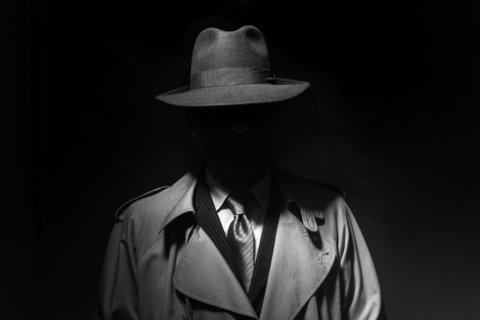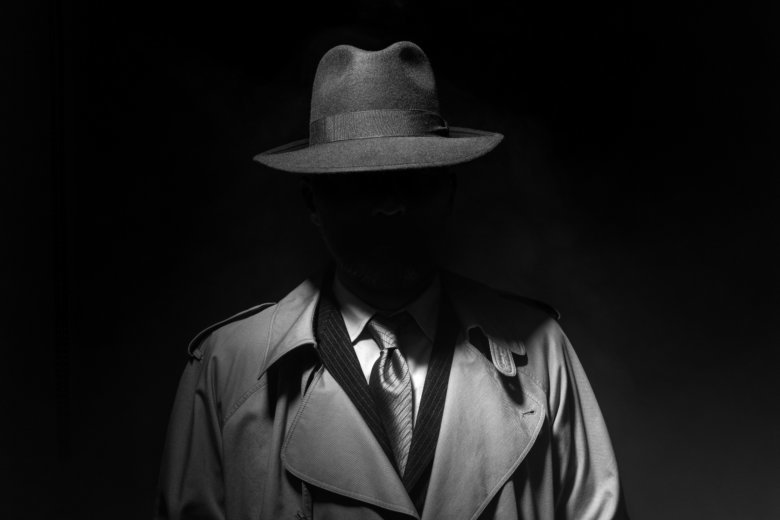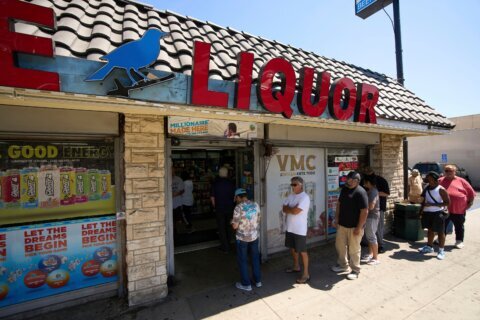
The two police officers trailed the university professor as he left his home in the southwest London suburbs and walked to the local railway station.
His name was Eric Burhop. An Australian immigrant who had become one of the United Kingdom’s leading nuclear and theoretical physicists, he was also a former member of the team that built the first atomic bomb, a prominent peace campaigner, and the subject of surveillance by security services on at least three continents in the 1950s.
Tall and well built, with thinning hair and a ruddy complexion, Burhop walked “with a slight stoop and takes noticeably short strides,” a later report noted. “He usually carries a small brown attache case and raincoat. Wears herring-bone tweed sports coats and grey flannels, brown shoes.”
The officers, members of the UK’s national security-focused Special Branch, followed as Burhop took the train to London’s Waterloo station, where he was joined by a man of “medium build, oval face, clean shaven, tanned complexion,” with whom he proceeded to University College London.
They watched Burhop all day, as he went about his academic duties, had lunch in the university canteen, visited a local bank, and bought the evening newspaper. Due to the size of the campus, they missed him going home for the evening, expressing frustration in a report that they had “insufficient personnel available to cover all the exits.”
In addition to the close surveillance of Burhop’s activities — one unlucky officer sat and watched him plant flowers in the garden of his house for several hours — documents show his letters and telegrams were intercepted, his phone was tapped, and his friends and acquaintances investigated.
The surveillance, and a growing suspicion by the UK authorities that he had at least at one point been a spy for the Soviet Union, is documented in newly discovered files in the British archives.
“This is a curious case of an (alleged spy) who was allowed to hide in plain sight in London,” said Susanne Roff, a UK-based researcher of nuclear history. Roff discovered the files in the British archives while researching the UK’s nuclear tests in Australia.
Burhop died in 1980. The documents show he was never brought in for questioning by the British security services, nor was he arrested for his alleged spying. He may have been unaware that he was under surveillance at all.
His story touches on the deep paranoia in the early decades of the Cold War, and the numerous intelligence failures by the British security services who, on discovering another alleged spy within their jurisdiction — following multiple embarrassing defections — appear to have decided it was easier to leave him be rather than draw attention to their own potential failings.
CNN has reviewed the documents provided by Roff, as well as additional — since declassified — secret surveillance records on Burhop found by CNN in the British and Australian archives. Two independent academics also reviewed the documents on CNN’s request. Their conclusions are presented below.
In a statement, Burhop’s children pointed out that he was never publicly accused of being a spy for the Soviet Union or any other country, nor charged with any crime. They expressed concern that this article would mar the memory of “a hugely respected man of the highest integrity” who devoted his life to science and peace.
“He was a man of peace who worked tirelessly towards a nuclear bomb-free world,” the statement said. “(We) would hate to see all that he achieved being hugely diminished by suggestions that he was a spy.”
New reality
At 7:00 a.m. on August 29, 1949, a mushroom cloud bloomed over a remote part of the Kazakh steppe.
The event, which was held in secret, changed the world.
“We have evidence that within recent weeks an atomic explosion occurred in the USSR,” President Harry Truman said in a statement to the American people about a month after the detonation.
“Ever since atomic energy was first released by man, the eventual development of this new force by other nations was to be expected. This probability has always been taken into account by us.”
While US officials may have always anticipated the Soviets would join the nuclear club at some point, the speed at which they did came as a great shock. Months before the Kazakhstan experiment, American intelligence agencies were still predicting mid-1953 as the “most probable date” for a Soviet bomb.
The successful first test by the Soviet Union, and the end of Washington’s nuclear monopoly, led to a massive increase in military spending in the US as the Cold War escalated.
The test also served to reinforce Washington’s earlier decision to exclude its allies from all future nuclear research. Three years before the Soviet test, the Atomic Energy Act — known as the McMahon Act — was passed in the US. Outwardly, the act was intended to formalize civilian control of the US’ nuclear industry. But it had a second purpose: tightening security.
Under the act, all information concerning the development and manufacturing of nuclear weapons was reclassified as “restricted data,” meaning it could no longer be shared with allies.
These security concerns appeared to have been thoroughly vindicated when, months after the first Soviet test, it emerged that a British scientist on the team which developed the US bomb, Klaus Fuchs, had been leaking information to Moscow throughout World War II and after, according to the British security services.
Other spy scandals would soon follow, with senior members of the British Foreign Office and spy agency MI6 revealed to be secret Soviet agents.
British invasion
At the start of the 1940s, as various powers raced to be the first to complete a then still theoretical atomic weapon, the UK’s nuclear program was ahead of the US, with British scientists making key discoveries into how uranium fission could be used to create a powerful bomb.
Following Washington’s entry into World War II in late 1941 after the Pearl Harbor attack, funding for nuclear research ramped up, and it soon became apparent that a joint program would more quickly deliver a bomb that researchers thought could potentially end the war.
In August 1943, leaders Winston Churchill and Franklin Roosevelt signed — in secret — the Quebec Agreement, which agreed the project would be “more speedily achieved if all available British and American brains and resources are pooled.”
A number of prominent British scientists went to work with J. Robert Oppenheimer’s team at Los Alamos. They included two naturalized UK citizens, German Klaus Fuchs and Australian Eric Burhop.
A member of the German Communist Party, Fuchs had fled to the UK in 1933 as the Nazis cracked down on their left-wing opponents. He earned a doctorate in physics from Edinburgh University, and in 1941 joined the UK-based precursor to the Manhattan Project, according to Britain’s MI5.
Fuchs, through another exiled German Communist, got in touch with Soviet military intelligence and passed on secret documents on the atomic program. At Los Alamos, Fuchs had a “key role in the project over the next three years, developing many of the designs, equations and techniques used to build the first atomic bombs ” — information which he passed to his Soviet handlers, according to MI5.
“When combined with information from other sources, this helped the Russians to make rapid progress in developing what was effectively a copy of the American atomic bomb design,” MI5 said in a report on Fuchs.
Another scientist on the British nuclear program, Italian Bruno Pontecorvo, was also later found to be sharing information with Moscow. Pontecorvo defected to the USSR in 1950.
While the US had its own problems with spies — such as Manhattan Project member Theodore Hall, and the Rosenbergs — officials in Los Alamos and Washington were furious with the British over the leaks, and regarded the UK as amateurish when it came to counter-intelligence, Roff said. The defection of MI6 agent Kim Philby in 1963 and the exposure of the Cambridge Five spy ring, a group of Soviet agents in the British government, would do little to change this opinion.
“The Americans were highly critical even though they had their own spy problems. They thought the British were very, very weak on security,” Roff added.
Following the war, Burhop continued his work at the top levels of theoretical physics, and went on to be a leading peace and anti-nuclear campaigner, winning multiple international awards for his activism.
Australian nuclear expert
Eric Burhop was born in Hobart, Tasmania in 1911. A gifted and precocious child, he excelled at school and won several scholarships, eventually studying mathematics and physics at Melbourne University.
In 1932, he moved to the University of Cambridge to work at the prestigious Cavendish Laboratory.
“This was a very exciting time to go to the Cavendish,” Burhop said in an interview he gave for an oral history project in 1970. “It was the center of nuclear physics in the whole world.”
In Cambridge, Burhop met another Australian physicist, Mark Oliphant, later a key member of the Manhattan Project who helped pave the way for British scientists to join the US nuclear program. In 1944, by then a naturalized British citizen, Burhop was recruited by Oliphant to work on the nuclear weapons project. Another Australian scientist, Harrie Massey, joined them.
“I was asked to work on the development of nuclear weapons,” Burhop said in the 1970 interview, adding that while he was something of a pacifist, “I did feel this was very justified at the time.”
“The discovery of nuclear fission was a German discovery and it appeared very likely that German physicists would be developing nuclear weapons,” he said. “One knew that if the Nazis were to obtain this weapon then it would have a a decisive influence on the war, and Hitler would have no inhibitions about how to use the weapon.”
It was around this time that Burhop first came under close observation by the security services. Like many at Cambridge at the time, he made no secret of his left-wing politics, and was believed by the security services to have been a member of the Communist Party of Australia (CPA) before he left that country.
According to a file kept on Burhop by the Australian security services, in the early 1940s he lectured at events organized by CPA-linked groups. A secret investigation of Burhop carried out by the Australians in 1944 around the time he left for the US concluded that while he was “somewhat ‘pink’ (he) is regarded as intensely loyal.”
While wartime officials in the UK and US were not exactly sympathetic to the Communist cause, the Soviet Union was their most important ally in fighting fascism in Europe, and so Burhop’s alleged sympathies — which were shared by many leading scientists and academics at the time — were not necessarily disqualifying.
Klaus Fuchs, the German-Briton who would later be exposed as a Soviet spy, was a known Communist Party member with less clear loyalties to the British Crown than his Australian colleague.
“There was an awful lot of sympathy for the Soviet Union during the war and post war years,” Roff said, both from those on the left who supported its political goals, and more generally due to the massive loss of life in the USSR during the war and its pivotal role in defeating Nazi Germany.
“There was a considerable number of communists, socialists and fellow travelers in the upper echelons of British diplomacy and other fields, particularly in the laboratories of Cambridge,” she added.
Burhop’s alleged “pink-ness” — slang for communist sympathies — may not have been seen as overly concerning then, or indeed that unusual. This changed, however, in 1950, with the arrest of Fuchs. The German was caught after US intelligence succeeded in breaking the encryption of top-secret USSR cables, known as the Venona Intercepts.
Following Fuchs’ arrest, the British spy services received a report from the FBI — marked Top Secret — warning that “as late as 1945 an Australian atomic scientist who worked on an Atomic Energy project was in close touch with Communist Party members in Brooklyn, New York, and through them with the highest Communist officials in the United States.”
“This Australian atomic scientist passed on everything he knew” about the program, and the Los Alamos setup, the report said, without identifying who of the eight listed scientists the FBI suspected of being the man in question.
In the UK, files were opened on Oliphant, Massey and Burhop by MI5, with suspicion soon falling on the latter. As his case officer A. F. Burbidge wrote in a May 1951 memo, “it has become increasingly clear since his arrival in the United Kingdom in November 1945 that Burhop is a thorough-going Communist.”
“Although not conclusively identifiable from the F.B.I. information, Burhop is the person who appears most likely to be identical with the scientist in question,” Burbidge added.
A ‘crypto-Communist’
While he was put under surveillance, Burhop was never brought in for questioning by the British security services, nor was he arrested for his alleged spying.
According to Roff, this is likely because the information pointing to Burhop came from the Venona Intercepts, still then a highly classified source of intelligence.
“(The intercepts were) deeply, deeply secret to the Americans, they didn’t want the Russians to know they could do it,” she said.
Unlike Fuchs, who confessed to his spying under intense interrogation, saving MI5 from having to reveal the Venona intelligence, the documents suggest officials felt Burhop would have been a tougher nut to crack and questioning him may have revealed the US and Britain were decrypting those top-secret Soviet cables.
In a report on Burhop marked as “secret,” discovered by Roff, R. F. G. Sarell, an official at the Foreign Office, wrote that he “is a crypto Communist and we are debarred, for security reasons, from admitting our knowledge of his Communist affiliation.”
A set of minutes from a Foreign Office meeting also reference Burhop’s believed Communist affiliation, but added this “could not be mentioned because MI5 had the information from a secret source, which could not be compromised.”
“Dr. Burhop claims that he is not a Communist and we should have got ourselves entangled in a fruitless argument with him if we had said he was,” the Foreign Office minutes said.
Elizabeth Tynan, an expert on the British-Australian atomic test program, said that “several Manhattan Project physicists (including Oppenheimer) were known to have communist sympathies and of those some became spies.”
She pointed to the case of the American Ted Hall, who was investigated by the FBI and widely believed to be a spy but was never charged. Hall’s alleged spying did not become public knowledge until the declassification of the Venona Intercepts program in the 1990s.
Hall never admitted to being a spy, but before he died he defended the sharing of information about nuclear weapons with other countries in order to end the American monopoly on the atomic bomb.
Darren Holden, an expert on World War II-era atomic scientists at the University of Notre Dame Australia, said the documents, and others that he had reviewed, showed there was a suspicion “that there was an Australian operating inside Berkeley” — where some of the Manhattan Project team, including Burhop and much of the UK delegation, was based — who was leaking information to the Soviets.
“Burhop is probably as likely a candidate as any,” Holden said. However he added that while Burhop was clearly viewed with great suspicion by the UK authorities, they never presented any conclusive proof of his spying.
“In this McCarthyist era, people got tarred and feathered for being members of the (Communist) party, does that necessarily make them spies?” he said.
“The only place you can find (definitive) evidence for these people being spies is either they’ve admitted to it or in the Soviet archives.”
In their statement, Burhop’s children said their father “never made any secret of his very left-wing views, which would have been an anathema in the United States when you recall the McCarthy vendettas against very left-wing and communist people.”
Problematic passport
Throughout this period, suspicion of Burhop was growing, and he remained under intense observation by the British security services.
“Observation was imposed on 21 The Ridge, Surbiton, and at 10 a.m. Burhop rode off in the Surbiton direction returning within half an hour with a box of plants. He was seen later dressed for gardening and shortly began planting out,” one report from June 1951 recorded.
However the following month, perhaps unbeknownst to him, Burhop forced the authorities’ hand.
Since the end of the war, Burhop — like many scientists involved in the Manhattan Project — had become disillusioned with nuclear weaponry and the rapidly escalating Cold War. Many atomic scientists were appalled at the bombing of Hiroshima and Nagasaki, which they viewed as needless both to end the war and to demonstrate the strength of the new weapons.
“A nation which sets the precedent of using these newly liberated forces of nature for purposes of destruction may have to bear the responsibility of opening the door to an era of devastation on an unimaginable scale,” 70 members of the Manhattan Project wrote to Truman ahead of the Hiroshima bombing.
Roff said that for the “scientists who actually made the (bombs), some of them felt very guilty, some of them felt very angry — they had built a genocidal weapon, then it had been used. How do you live with yourself after that?”
Burhop, she said, “was part of this group of disaffected scientists who felt that the only way forward was to stop America being the only nuclear power and to have a proliferation of nuclear capacity.”
The Australian scientist became involved in the anti-nuclear and peace movements. In his writings, he criticized the West, exemplified by the recently created North Atlantic Treaty Organization (NATO), for needlessly escalating tensions with the USSR, and expressed a desire to see the two sides come together, as they had been during World War II.
“Many of us felt that having played a part in the development of nuclear weapons we had a duty and responsibility to do our utmost to see that they were never used again,” Burhop said in 1970.
In their statement, Burhop’s children said he “spent much of his free time in the late 40s talking to anyone and any society about his strong conviction that atomic energy would be of huge potential as a source of electrical energy for mankind, while at the same time expressing his concern about the development of nuclear weapons.”
In July 1951, Burhop signed up for a trip to Moscow as part of a delegation of British scientists organized by the Society of Cultural Relations with the USSR.
When it learned of his intentions, the Foreign Office was appalled. After the McMahon Act, the UK had restarted its own atomic weapons program, and was preparing to conduct a first test at a site in Australia — one that would eventually see it become the world’s third nuclear power.
It was hoped that the successful detonation of a British bomb would see the McMahon Act restrictions rolled back on future cooperation, and the UK could take its place in the nuclear club as an equal.
“1951 was a tough year for British intelligence,” Roff said. “Fuchs had been terribly embarrassing.”
She added: “The last thing they wanted when trying to get back into bed with the Americans in Australia was that an Australian scientist shared secrets.”
Tynan, the British-Australian atomic test program expert, said the UK was until a late stage attempting to work with the US.
“Even after the selection of (the Australian) Monte Bello Islands for the first British test at the end of 1950, the British were still trying to work with the Americans,” she said. “But the Fuchs matter made it impossible.”
On July 18, two days before his Moscow trip, the Passport Office wrote to Burhop to inform him his travel document had been canceled and told him to surrender it. According to a set of minutes taken at a Foreign Office meeting, “we did not consider that we should discuss the matter with Dr. Burhop first.”
One of “our reasons for action was, quite frankly, that his journey to Moscow would have created the worst possible impression in the USA,” the minutes added.
Foreign Office official William Harpham issued an order to cancel Burhop’s passport, preventing him from leaving the country.
“One of the considerations I have in mind in making this recommendation is that our main object, as I see it, is to be able to show the Americans and our own public that we have done our utmost to prevent Dr. Burhop’s journey,” he wrote in a memo. “The available information indicates that Dr. Burhop has no recent classified atomic information in his possession and he has probably already passed on everything he knows about the American atomic energy project so that, apart from the effect on public opinion, it is arguable that it would not really matter if Dr. Burhop did get away.”
Holden, the University of Notre Dame Australia expert, said that governments on both sides of the Atlantic were uncomfortable with how atomic scientists were speaking out after the war on a number of issues.
“Scientists speaking up in politics, entering the political discussion, that was quite a threat to governments,” he said. “Scientists were held up as these great saviors, on the front page of newspapers, they started to say a message that the government didn’t want to hear.”
‘No sinister scientist’
After years of being passed around by intelligence agencies, the accusation Burhop was a secret Communist was now somewhat in the open. News of his passport being revoked made it into the press and the story was picked up widely.
In a July 1951 interview, Burhop pushed back hard against the government, saying: “I am no sinister scientist; I work for peace and peace alone.”
“The Government has made me a test case and has infringed my rights as a British citizen,” he said. “It has made every atomic scientist a marked man. It means that an atomic scientist is really a prisoner … I wanted to go to Russia because I believe that visits between intelligent people on both sides of the Iron Curtain are the best and only way of breaking down the tension.”
After seeking to avoid the embarrassment of a potential defection, the British government now had a scandal on its hands. Unable to prove publicly that Burhop was a Communist — despite the apparent certainty of MI5 that he was — officials backed down, reissuing his passport, though only after he provided an assurance he would not travel to the USSR.
A declassified file on Burhop showed MI5 continue to surveil him until at least 1958, and even after he was reissued a passport, his movements were still restricted and he could not travel to the Soviet Union or allied countries.
His passport returned to him, Burhop continued his work at University College London, where he had moved after the end of the war, including important findings in theoretical and nuclear physics, and in 1963 was elected to the Royal Society, the UK’s most prestigious scientific body.
In the ’50s, he worked at the European Organization for Nuclear Research (CERN), where he was instrumental in work on particle accelerators which led to the Large Hadron Collider, currently the world’s largest and most powerful particle collider.
He also remained active in the peace and anti-nuclear movements, helping to found the British Society for Social Responsibility in Science and organize the Pugwash Conferences on Science and World Affairs. In 1966 he was awarded the Joliot-Curie medal of the World Peace Council, and in 1972, the Lenin Peace Prize.
“During most of my scientific career I have been very interested in the problems of the implications of science and of the social responsibility of the scientist,” Burhop said in 1970. “I myself have devoted most of my spare time activities since the end of the war to this purpose.”
In plain sight
Burhop died in London on January 22, 1980, of complications related to stomach cancer. His entry in the Australian Dictionary of Biography describes him as “a prodigiously hard worker, but also a devoted family man.”
Was he also a spy? All that can be said for certain is that some of the MI5 agents who investigated him felt he was. He was never charged, let alone convicted, with any crime, nor was he given a chance to defend the allegations against him in court. The one time he was confronted with suggestions he was anything but loyal to the UK, in 1951, he strenuously refuted them.
In their statement, Burhop’s children said he was a “man of peace.”
“This was his driving force with all his political actions. He was also a distinguished physicist, a Fellow of the Royal Society, and was awarded various honors during his life,” they said. “At the time of the passport withdrawal such allegations (of being a spy) were made and I believe three newspapers were sued for their accusations — our first car was nicknamed DaiTel being paid for by the Daily Telegraph.”
The period of the UK’s suspicion and surveillance of Burhop was a deeply paranoid one, caused both by a rapidly escalating Cold War between the West and the Soviet Union, and by real — and hugely embarrassing — revelations of spies embedded within the British elite.
“During the war and in the Cold War era there were no really blurred lines, everything was really black and white,” Holden said. “It’s like when George W. Bush said you’re with us, or you’re with the terrorists.”
At the time of the Manhattan Project, the Soviet Union was an ally of both the US and the UK, and while Moscow was not invited to be involved with the nuclear weapons development, passing information regarding it would not have been an act of treason.
Fuchs, the confessed atomic spy, was instead convicted of breaching the Official Secrets Act and sentenced to the maximum 14 years in prison. Due to the classified nature of the Venona Intercepts, had he not confessed, it’s unlikely even this conviction would have been successful.
The Venona program continued until 1980, and was not declassified until 1995 — 15 years after Burhop’s death.
There is no record of Burhop ever being questioned by the British authorities. Why he was apparently not questioned is unclear.
While concerns about compromising Venona and other sources undoubtedly played a role, the archives offer little insight into why there was not even an attempt to get a confession out of Burhop as had been done with Fuchs, beyond a suspicion he would push back against the accusations. This could point to an uncertainty about the allegations against him that is not present in the text of the documents themselves.
While Roff argues the documents show the authorities clearly felt Burhop was a spy, Holden was more skeptical, saying they lacked definitive proof of wrongdoing that, short of a confession, would be hard to come by. “Even today we can assume that many people who offer no credible threat to society are being monitored,” he said.
In a statement, the Burhop family said that Eric Burhop “vowed never to work on military work again after he witnessed the results of the Manhattan Project and he became one of the foremost scientists of his time in high-energy physics,” adding they “would hate to see all that he achieved being hugely diminished by suggestions that he was a spy.”
“He was a man of peace who worked tirelessly towards a nuclear bomb-free world,” the family said.








